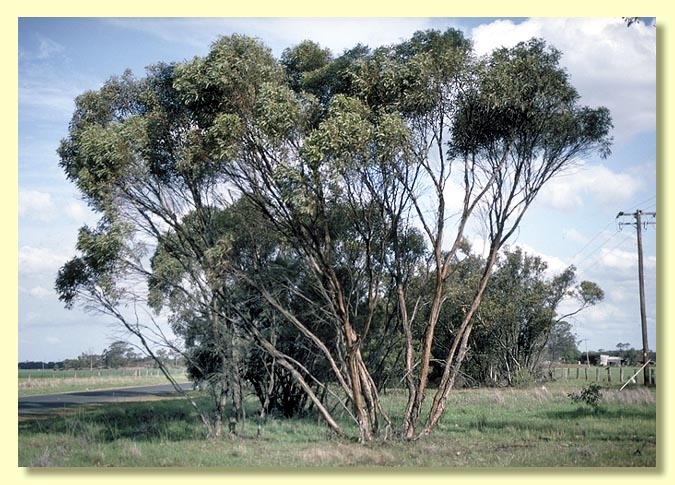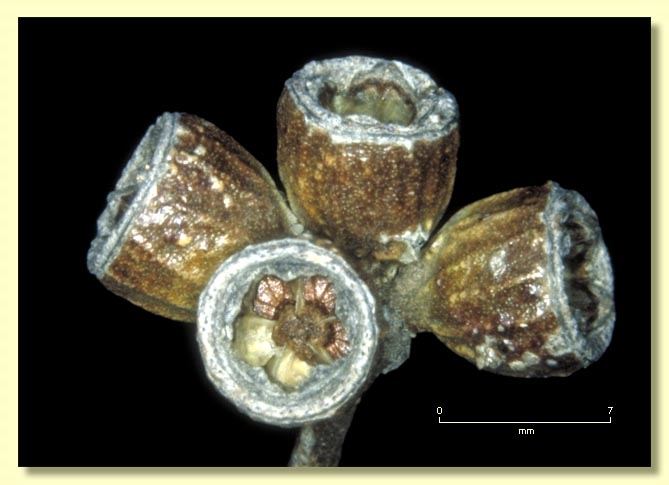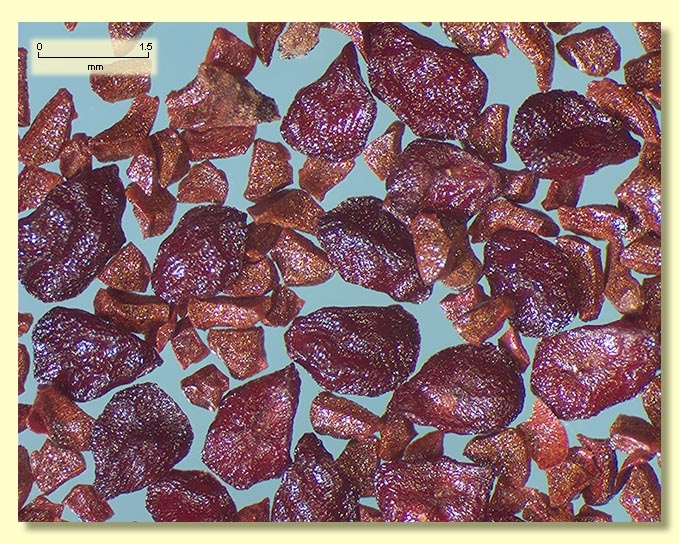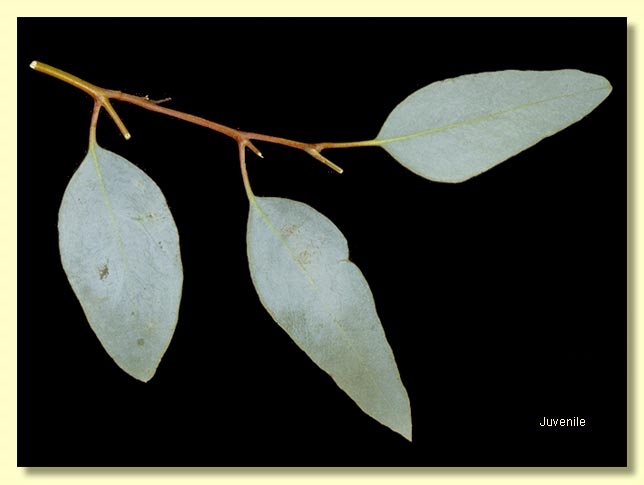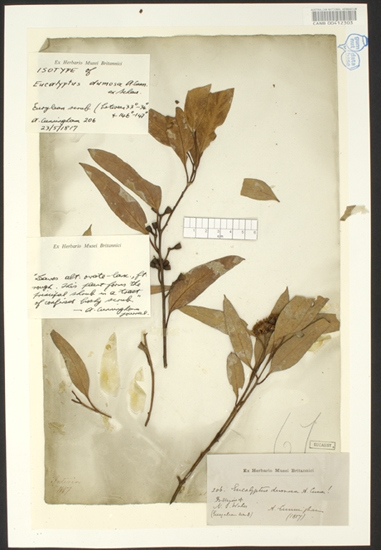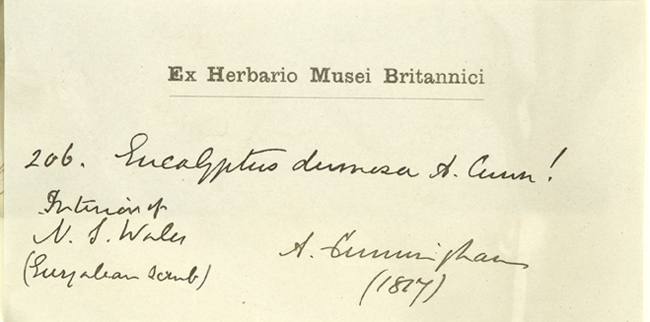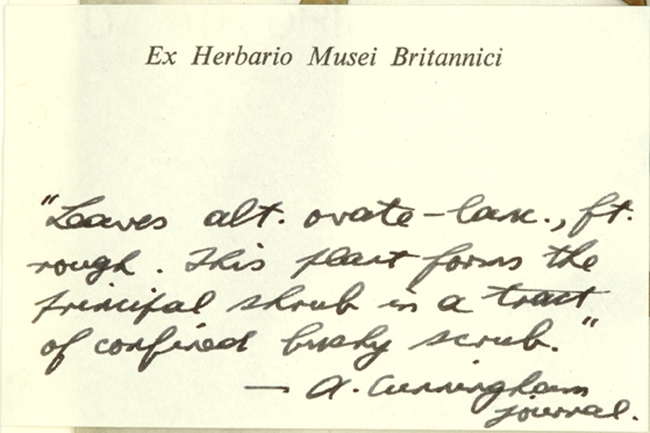Euclid - Online edition
Eucalyptus dumosa
Eucalyptus | Symphyomyrtus | Dumaria | Rufispermae
Eucalyptus incrassata var. dumosa (A.Cunn. ex J.Oxley) Maiden, Crit. Revis. Eucalyptus 1: 96 (1904). T: Euryalean Scurb, between 33°and 34°S, and 146° and 147°E, NSW, 23 May 1817, A.Cunningham 206; iso: BM, CANB, E, K.
T: not designated.
Eucalyptus muelleri Miq., op.cit. 130.
T: 'Madam Pepper-wealth ad fl. Murray'; F.Mueller.
Bark usually rough on lower part of stems, grey or grey-brown, flaky or box-type; smooth bark white, yellow, grey, brown or pink-grey, shedding in ribbons from the upper stems and branches, rarely powdery.
Branchlets with oil glands in the pith.
Juvenile growth (coppice or wild seedling to 50 cm tall): stem rounded in cross-section; juvenile leaves always petiolate, opposite for 2 or 3 pairs then alternate, petiolate, ovate to broadly lanceolate, 5.5–14 cm long, 2.2–7 cm wide, blue-green or grey-green.
Adult leaves alternate, petiole 0.8–2.5 cm long; blade lanceolate to falcate, 4.8–12 cm long, 0.8–2.5 cm wide, base tapering to petiole, concolorous, usually dull, blue-green to grey-green or almost grey, or maturing glossy green, side-veins at an acute or wider angle to midrib, moderately to very densely reticulate but with veinlets erose, intramarginal vein parallel to and just within margin, oil glands numerous mostly intersectional or obscure.
Inflorescence axillary unbranched, peduncles 0.5–2 cm long, buds 7 per umbel, usually pedicellate, rarely sessile (pedicels (0)0.2–0.5 cm long). Mature buds cylindrical (0.6–1.1 cm long, 0.3–0.5 cm wide), green or red, scar present, operculum slightly beaked to conical to turban-shaped to rounded (0.2–0.5 cm long), faintly striate to conspicuously so, stamens strongly inflexed, anthers cuboid to wedge-shaped, versatile, dorsifixed, dehiscing by longitudinal slits (non-confluent), style long, stigma blunt, locules 3 or 4, the placentae each with 4 vertical ovule rows. Flowers white.
Fruit usually pedicellate, rarely sessile (pedicels (0)0.1–0.4 cm long), cup-shaped to cylindrical or barrel-shaped, 0.4–0.9 cm long, 0.5–0.7 cm wide, sometimes slightly ribbed longitudinally, disc descending, valves 3 or 4, slightly exserted, near rim level or enclosed.
Seeds reddish brown and glossy, 1.0–3 mm long, irregularly ovoid or flattened-ovoid, often pointed at one end, dorsal surface shallowly reticulate, sometimes lacunose, hilum ventral.
Cultivated seedlings (measured at ca node 10): cotyledons reniform; stems usually square in cross-section; leaves always petiolate, opposite for 5 to 10 nodes then alternate, ovate, 4–9 cm long, 2.5–5.5 cm wide, dull, bluish green.
Flowering has been recorded in February, March, April, May, August, September and December.
A mallee widespread in mallee scrubs of south-eastern Australia, from central New South Wales south of Dubbo and Louth to north-western Victoria west of about Swan Hill, and into South Australia extending through the Murray Mallee to the Flinders Range from near Quorn north to Freeling Heights and to Mount Remarkable and the York Peninsula; absent from the Eyre Peninsula. It prefers harder, heavier soils in this area. Eucalyptus dumosa has a stocking of rough bark and the adult leaves are usually dull, green to grey-green, often maturing to glossy green inside the crown. Some populations in south-western New South Wales have conspicuously greyish leaves.
In the classification of Brooker (2000) Eucalyptus dumosa belongs in Eucalyptus subgenus Symphyomyrtus section Dumaria having these features: buds initially with two opercula the outer shed early, stamens strongly inflexed, ovules in 4 rows on the placentae and cotyledons reniform. Within section Dumaria the species belongs to a large sub-group of closely related species (series Rufispermae, 37 described species and subspecies) diagnosed by glandular pith in the branchlets, anthers cuboid to wedge-shaped, versatile, and by the reddish brown and glossy, seeds which are unique to the series.
In its natural distribution E. dumosa may be confused with E. phenax subsp. phenax, which differs by having consistently glossy, green adult leaves and smooth stems. E. percostata, a species with restricted distribution in the southern Flinders Ranges, has dull leaves and coarser, more ribbed buds and fruit than E. dumosa. In the Murray Mallee another related species, E. cyanophylla, is found between Renmark (South Australia) and Morkalla to Murrayville (Victoria). It has a much greyer appearance with wider buds and fruit and broader adult leaves than E. dumosa.

